To tease or not to tease, that is the question.

It’s finally here! I’m going to guide you through the process of writing a first act in the month of March. The goal will be to write 30 pages. You might be wondering why not 25 pages, which is the page count I usually promote for a first act. It’s because first acts are always bloated. You’ll be figuring a lot of stuff out in any first act which means you’re going to run long. And that’s a good thing. It’s way easier to cut pages than add pages. So don’t feel any restraint here. It’s okay if you write a big fat first act.
To start this process off, we’re going to talk about teasers.
Should you write one? Should you not write one?
A teaser is an exciting opening scene that is often dissociated from the linear narrative and which rarely contains your main character. The bank robbery scene in The Dark Knight is a teaser scene. The black man who gets taken in a suburban white neighborhood in Get Out is a teaser scene. A well-written teaser will immediately grab the reader, which is why a lot of writers write them.
Another reason writers turn to teasers is because their story isn’t set up in such a way that it opens with an exciting scene. A perfect example is Die Hard. Die Hard actually starts out with a boring first scene because the terrorists hadn’t started doing their terrorizing yet. So we get a scene of John McClane lazily flying into Los Angeles. Now you may say, “Well isn’t this proof, Carson, that you don’t need to open with a flashy scene? Die Hard became one of the best movies of all time.”
True, but this is where I remind you that DIE HARD WAS NOT A SPEC SCRIPT. It was an adaptation. It didn’t have to win any readers over. Your script WILL need to win readers over, which is why, if your script doesn’t organically start out with an entertaining scene, you should consider a teaser.
A teaser can basically be set anywhere. You can set it 300 years ago. You can set it 3000 miles away. You can use it to introduce your villain. You can grab a fun scene from later on in the script, a practice almost every screenwriter has used at some point in their career. They’ll fast-forward to one of the cool parts of the story, use it as their teaser, then cut to present day, where we stay until we revisit this moment later on. You’ll know you’ve seen this teaser when the following scene opens with a title card that says, “3 Days Earlier.”
Teasers were basically created for increasingly impatient audiences. Back in the 70s, moviegoers just wanted to sit down and relax. They didn’t give a sh#t if it took an hour to set up the film. But these days people are ready to move on if they get a mildly amusing text from their work buddy, Chuggs. So teasers have become a tool to combat boredom.
But teasers bring with them their own bag of problems. I often read teasers that don’t deserve the teaser title. A weak teaser I commonly run into is a woman driving her car down an empty wooded road at night (or a character in some dark secluded place where no one can hear you scream). She runs out of gas so she pulls over. She then thinks she sees someone up ahead. So she gets out of her car, walks forward, and asks if anyone is there. Then we see her eyes grow big as she sees something off-screen. Whatever the thing is, it attacks her. But before we can see the attack, the scene ends.
Not only is this a really boring predictable teaser I’ve seen a million times already. But it’s too short. It doesn’t give us any unique information. A teaser scene is almost like a mini-movie. It needs detail. It shouldn’t operate on generalities and cliches. The Hans Landa opening in Inglorious Basterds is a great teaser. Or the babysitter scene in Scream. These are full scenes – mini-movies if you will – that provide a very specific and entertaining story.
But therein lies the second issue when you write teasers – especially long teasers – which is that it f#cks up your page structure. There’s so much you have to set up in a screenplay. So if you write a long teaser scene, such as the one Tarantino wrote in Inglorious Basterds, that pushes your entire structure back 12 pages (the length of the scene). So instead of the inciting incident happening on page 12. It’s now happening on page 24.
I’ve seen many writers get confused by this. They’ll still try to hit their beats going off a traditional first act breakdown. So they’ll try and come up with an inciting incident immediately after their 12 page teaser is over, since page 12-15 is when your inciting incident is supposed to happen. Except how can you disrupt a character’s life (which is what the inciting incident does) if you haven’t even shown us that life yet?
This leads to writers talking themselves into things. They’ll say stuff like, “Well, that moment in the teaser did disrupt my hero’s life so that means it’s the inciting incident,” when that might not be the case.
As you can see, whether or not you start with a teaser is a big decision. There are repercussions to using them. Which is why I prefer that writers start with a scene that grabs the reader right away, *but is within the flow of the story.* It’s not an isolated teaser from another time or place. It introduces us to our hero. It shows them doing something interesting. A good example of this would be the opening scene for Don’t Look Up. We see our main character, played by Jennifer Lawrence, discover the comet that’s going to collide with earth.
You could’ve done this with Die Hard, by the way. You could’ve started with John McClane taking down a criminal back in New York. Then, the very next day, he has to head to Los Angeles. But therein lies the opening scene paradox. You are supposed to start your screenplay as late as possible. The later you start it, the quicker we get to the good stuff. If you start Die Hard back in New York with John McClane taking down a bad guy, you are not starting your story as late as possible.
To summarize, I prefer opening scenes that grab the reader, but are within the flow of the story. These scenes allow you to set up your character as well as the world they live in. So you’re getting more bang for your buck. However, if your story doesn’t allow this, consider a teaser. Because it is imperative that you grab the reader right away. And if a teaser is the only way to do that, then write a teaser. Remember that readers have formed their opinion of you as a writer, formed an opinion on the first scene you’ve written, and formed an opinion on if they think your script has any chance at all at being good, all within the first couple of pages. So if you lay out a dud scene right away, forget about it.
There was this movie that came out in 2000 called, “Mission to Mars” which was as awful as the title implies. All the reviews of that movie highlighted that they knew it was going to be a bad movie based on the first scene. That’s because the scene took place at a barbecue with a bunch of the movie’s astronauts. The writer’s pursuit was noble. He thought the party was a perfect way to get all the astronauts in one place and, therefore, quickly set them up. But because it resulted in a ten minute scene of characters lazily chatting with each other, the audience checked out before the real story could even begin. That is the danger of writing a weak opening scene.
Technically, you only have to write 1.5 pages today but I figure most writers are going to be writing full scenes. So just try to write one scene today. It’s okay if you get ahead of the class. You can use the extra time at the end of each week to go back and rewrite your scenes. Or you can charge ahead and try to write the first act as quickly as possible. With that said, you’ll be missing specific instructions from me about each section you’re entering so take that into account.
Pages to write until next post: 1.5
Next Post: Tomorrow (Wednesday, March 2)
P.S. Let me know in the comments if there is anything about the first act that you want me to cover over the next month!
The March Scriptshadow Newsletter is in your inboxes!

A quick reminder that the Scriptshadow Newsletter just hit your inboxes. Make sure to check your Spam and Promotions folders if you didn’t receive it. E-mail me at carsonreeves1@gmail.com if you want to be added to the list.
In this month’s newsletter, I discuss a new method to ensure your screenplays never get boring. I share my thoughts on the next Showdown, which will be a radical departure from previous Showdowns. I give my thoughts on that new Lord of the Rings trailer, as well as a spec sale, a book sale, and a short story sale. I also highlight one of the spookiest horror shorts I’ve ever seen. Finally, I review a script that should be the prototype for making the Black List.
Okay, it’s FINALLY time. Starting tomorrow, you are going to begin writing the first act of a new screenplay! I am going to guide you through the process, going through all the little details of what each section should look like so that your first act rocks. After this de facto class, you’ll never struggle with writing a first act again.
The schedule is going to be messy, though. I’ll typically post three “First Act” articles a week, as well as one script review a week. All script reviews will focus on the script’s first act. However, there are snags we’ll have to deal with. We have the Amateur Showdown winning script review on Friday. I also plan to review the new Batman movie next Monday. So each week will probably have a small bump in the road.
In getting you prepped for tomorrow, let’s remind you what a typical first act looks like.
You’ll start off by introducing us to a character living an unfulfilled life. The reason they are unfulfilled is because that gives them room to grow (and transform) over the the course of the story. In addition to meeting your hero, we will follow them through their daily life, where we will learn about their job and the people in their orbit.
Something will then happen to jolt your hero’s life off its axis. This is often called the “inciting incident,” and it throws everything into disarray. Your hero will resist the change this new event brings. At a certain point, however, he will reluctantly accept the challenge, and he will go off on an adventure. Once he walks out that door, your first act is over.
The Hero’s Journey is the most traditional story and follows a character who’s yanked away from their home and thrust into a wild adventure. For that reason, The Hero’s Journey is the easiest first act to write. All the beats are clearly laid out for you.
Unfortunately, not every story lines up this way. You could be writing Cloud Atlas, which will have an untraditional first act. You could be writing a contained thriller, like Cloverfield Lane, that doesn’t have an adventure. You could be writing “Old,” where everybody just gets stuck on a beach. You could be writing “Before Sunrise,” where two people meet and just start talking for 90 minutes. You could be writing Pulp Fiction, where the non-linear first act is showing us things that happen after as opposed to before. You could be writing Joker where all the first act does is set up a disturbed character. There’s no “adventure” in that movie.
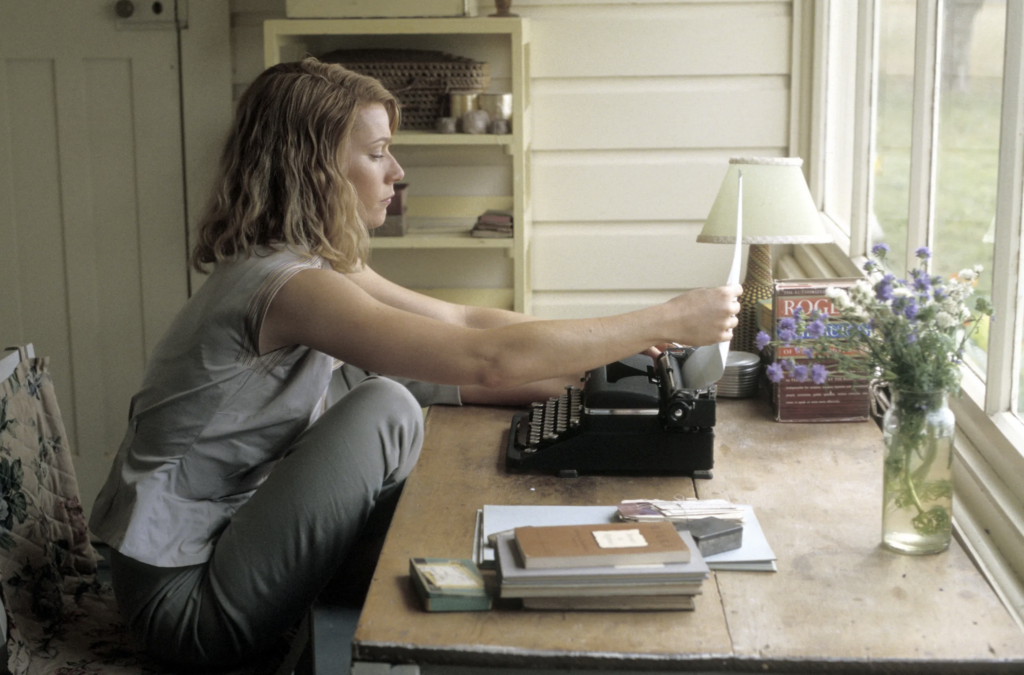
The point is that every story has different requirements. There is no one-size-fits-all first act. However, if there is a main character and that character has a goal they must achieve, then the first act steps I lay out this month should work for 95% of you.
As for page-writing requirements, technically, you only have to write one page per day. However, the schedule I’m laying out for you will have you moving a little quicker. I want you to write ten pages a week. That’s because I want to use the final week to go back into the act and clean it up. Here’s a rough outline of the posting schedule.
WEEK 1 – FIRST 10 PAGES
First Post – Figuring out whether to write a teaser or not. The pros and cons of teasers.
Second Post – The introduction of your main character and their flaw.
Third Post – Setting up your hero’s daily life; job, family, social.
WEEK 2 – SECOND 10 PAGES
First Post – Scene-writing. How to make sure you’re not just setting things up but rather keeping the reader entertained with well-written scenes.
Second Post -The Inciting incident. Your hero’s world is thrown into disarray.
Third Post – Introducing a memorable antagonist.
WEEK 3 – THIRD 10 PAGES
First Post -Dealing with all the excess exposition and setup involved in first acts.
Second Post – Refusal of the Call. The hero will cling to his flawed life, do anything to avoid change.
Third Post – Setting up that all important GSU.
WEEK 4 – THE CHALLENGES YOU WILL FACE
This week will be dedicated to the specific issues that come up over the first three weeks. I’ll address common questions, common concerns, and share certain hacks I’ve discovered over the years for dealing with first act frustrations. The quality of these posts will depend on you. So make sure you’re asking plenty of questions in the comments!
You should already have your concept picked out, a bare-bones outline written, and a good sense of who your main character is as well as their major flaw. If you have that, you should fly through this challenge. For those who have chosen a more “thrown into the lion’s den” approach to your first act, don’t worry. I will be there for you every step of the way and I *WILL* make sure you have a first act at the end of this.
Can’t wait to see what you guys come up with. Warm up those fingers and I’ll seeya tomorrow!
First of all, thanks everybody who submitted to the Showdown (a little over 300 of you!). You know I’d pick all of you if I could. But I could only choose SIX. Just know, I still love you! You should run your loglines by the readers of this site to see why you didn’t get picked. If you want to know straight from the horse’s mouth, you can order a logline consult from me. It’s just $25. E-mail carsonreeves1@gmail.com and put “logline” in the subject line.
But overall, this showdown was a blast. If only you could’ve joined me while reading through the submissions. A robot detective who is simply described as, “he has sex and vapes,” was sent my way. That’s my new character description of the year. We got our first ever script adaptation of a meme. Man has screenwriting changed since I was a kid. We had a theme park with reincarnated historical figures that almost made the cut. Multiple vampire huntress submissions were made (three, to be exact). Oh, we have a writer whose submission had to be voided because, in the time between when he submitted and now, his script got optioned and is being packaged by CAA (Take a bow, David Williams!).
So yeah, going through all those scripts was fun. But now it’s time to celebrate our six finalists. And it is up to you, the readers of this site, to decide the winner. Read as much of each script as you can, then vote on your favorite in the comments section (just post a comment with your pick). The winning script will be reviewed next week. You know what to do. Voting ends at 11:59pm Pacific Time, Sunday, February 27th.
And to the six of you who made Amateur Showdown… GOOD JOB and GOOD LUCK!
Title: Fish Story
Genre: Action, Comedy, Drama
Logline: Four seemingly unrelated stories, spanning over five decades, reveal how one of the first all-black punk bands recorded a song in 1974 that could help save the United States of America from a present day nuclear attack.
Why You Should Read: I’ve been writing for 16 years, mostly in the TV pilot world. Fish Story (2009) is one of my favorite movies, mostly due its infinite re-watchability and kick-ass title song. It’s also a Japanese movie, and I’ve gotten the rights to the short story Fish Story is based on by Kotaro Isaka (his latest book, Bullet Train, is being adapted into a movie starring Brad Pitt). For reference, my other favorite movies are Memento, Fight Club, Se7en, and Shaun of the Dead.
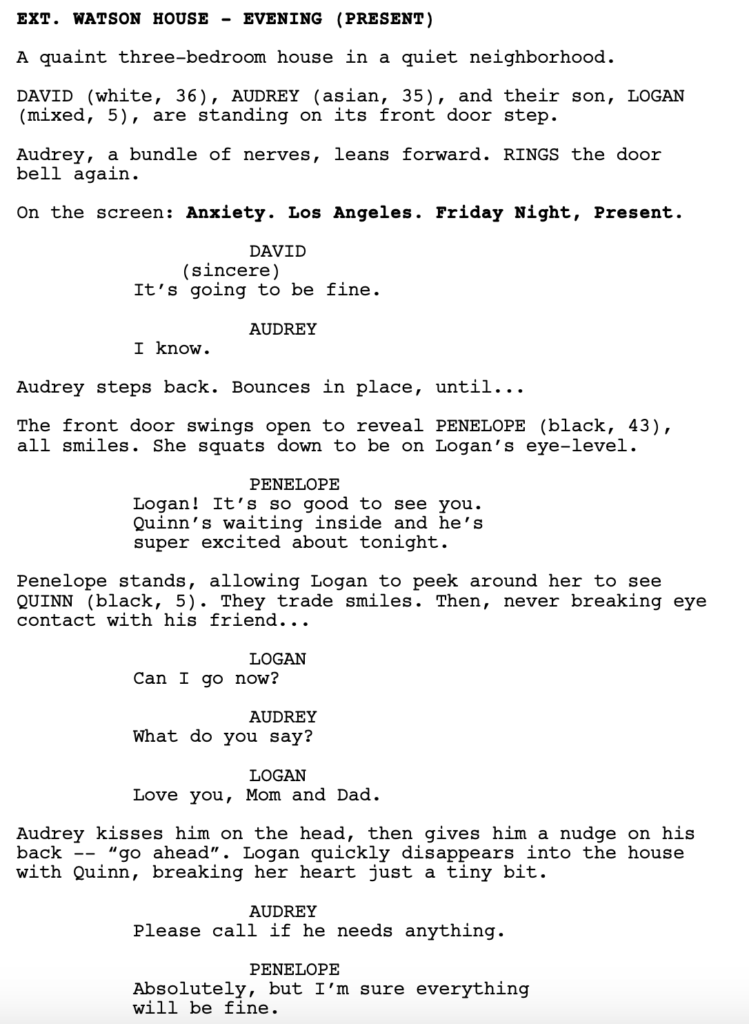
Title: Gladiator Warrior Battle-Dome 3000!
Genre: Sci-fi-Horror-Satire (this is anything goes round!)
Logline: After a botched robbery leads to their impending death, five dysfunctional criminals are transported into the future to become contestants on a game-show where they battle against teams from different historical eras in a futuristic gladiatorial arena to win a second chance.
Why You Should Read: After making the “High Maybe” list in the Last Great Screenplay Contest, and with the recent international success of Squid Game, I’ve continued to refine this outlandish, satirical action-horror. There’s time travel, a heist, and plenty of surprises along the way. I’d love to hear what Carson and the SS faithful have to say.
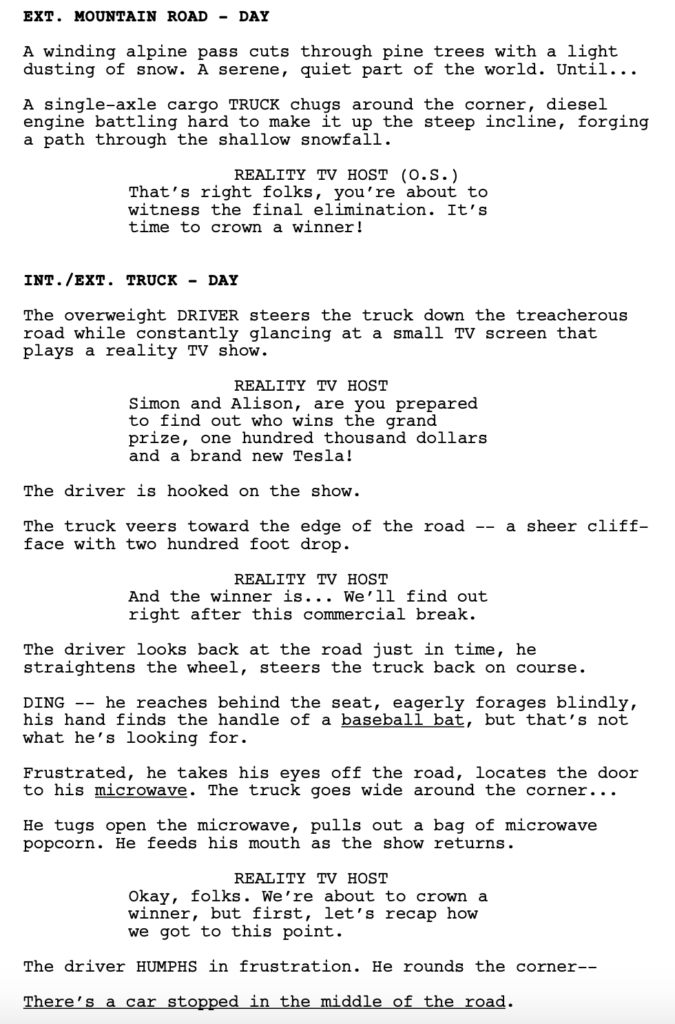
Title: POSSESSIVE
Genre: Romantic Comedy (with a pinch of horror)
Logline: A plucky young woman still recovering from a bad case of demonic possession returns to the dating scene hoping to find love, but having the devil as baggage sure isn’t helping.
Why You Should Read: I was raised by a single mom in a family with much darkness. Violence and addiction were all around. I retreated into my own world to escape that darkness. My own world was movies. Movies let me dream and laugh. Later, when I started writing screenplays, I realized that my darkness came through, but I always seemed to take that darkness and make it funny and hopeful. I love to write romantic comedies, but always with a twist. With POSSESSIVE, the jumping off point was, What happens after a woman recovers from a Demonic Possession? Does she date? How does she break the ice? What happens if she tries to hide her Possession from a guy she’s dating for as long as possible? I also wanted to deal with the affects a Possession would have on a person, since it’s a complete violation. How would someone cope with that trauma? POSSESSIVE is about the journey of Anna Norman – she’s funny, smart, shy, a little goofy, silly, persistent, and just happens to have been Possessed. Anna deserves her happy ending just as much as everyone else. POSSESSIVE is funny, heartfelt, romantic, and unique, and I think you’ll really enjoy it.
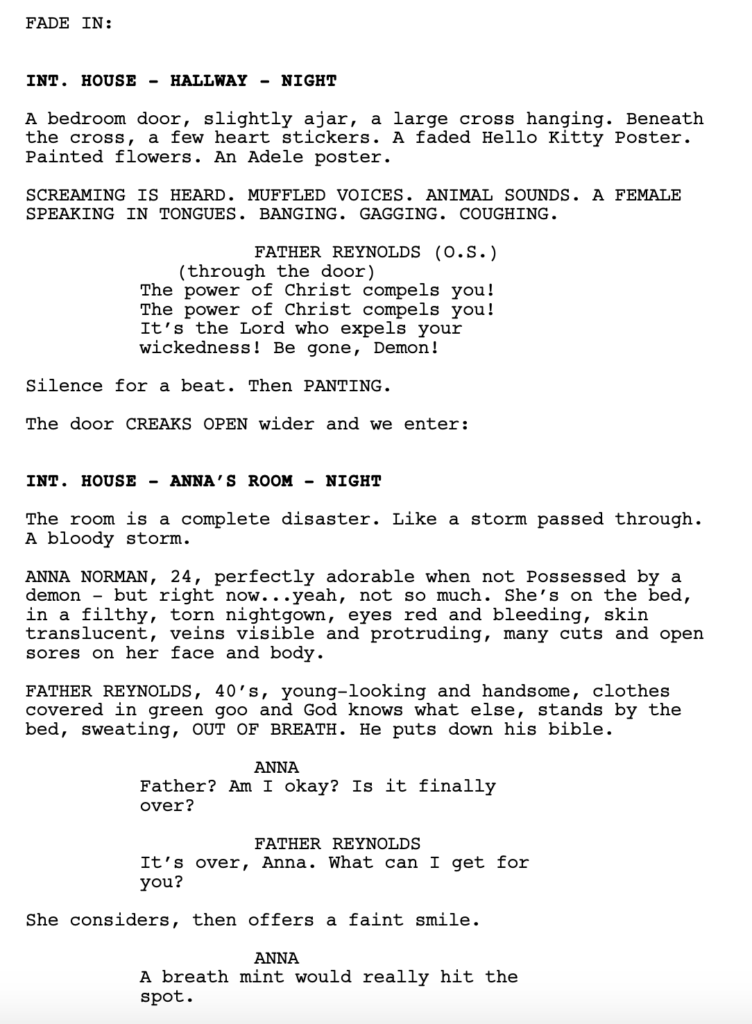
Title: DINAH
Genre: Family Comedy
Logline: In a world where genetically engineered “teacup dinosaurs” have become the world’s most popular pet, a recently widowed dad finally caves and buys one for his kids, but things go off the rails when the tiny dino grows into a full-sized brontosaurus named “Dinah.”
Why You Should Read: Hollywood is about high concept ideas and what’s better than a WORLD WHERE TEACUP DINOSAURS ARE PETS. Cute, tiny dinosaurs. Think of the merchandising opportunity… cha-ching! Plus this isn’t your typical kid-friendly family comedy. We push the edginess and make this fun for ALL ages. Plus, our zany villain has major Elizabeth Holmes vibes. Jurassic Park has basically saturated the market for “dinosaur” movies but luckily we have a fresh take on a type of movie that the whole family can enjoy. I mean, imagine a world where you walk down to grab your UberEats and you see a woman walking a tiny triceratops. That’s OUR world. It’s part BEETHOVEN and part JURASSIC PARK. Enjoy!
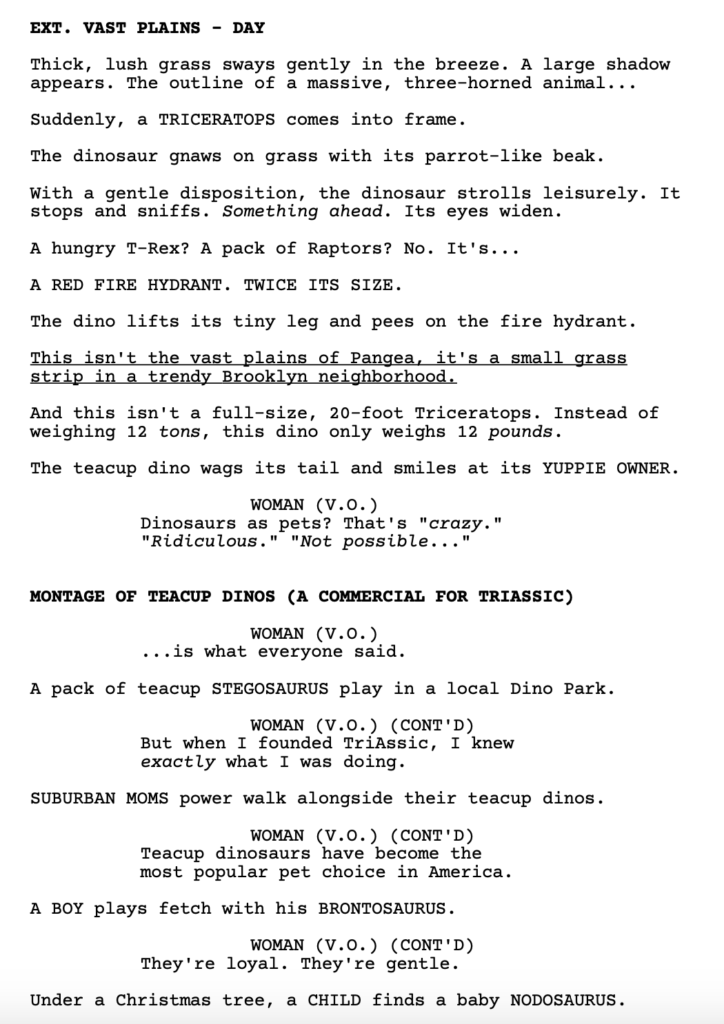
Title: The Last Scion
Genre: Action/fantasy
Logline: A combat veteran fights to keep his inexperienced squad alive in the remote Scottish Highlands as they’re hunted by descendants of a Celtic Demigod.
Why You Should Read: I’ll let the logline speak for itself, either it’s your bag or not ;)…. Comparisons: Dog Soldiers/Wickerman/Southern Comfort.
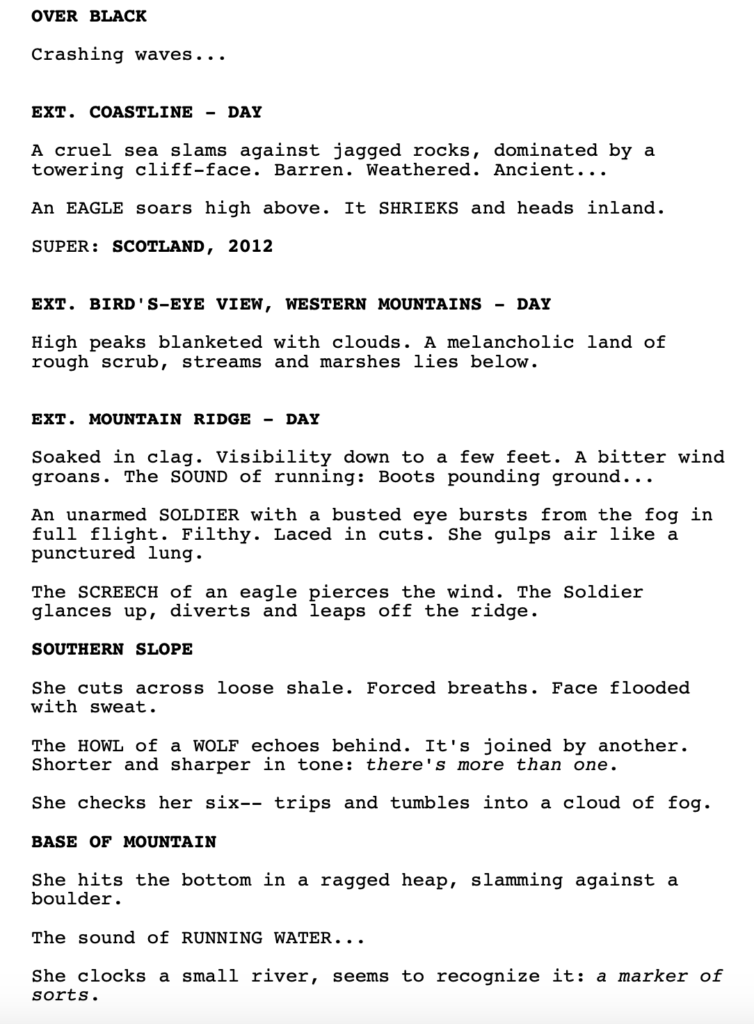
Title: Average Joe
Genre: Satire, Political Thriller
Logline: The ‘true’ story of Joe McCarthy, where he was just a patsy and the real threat was a secret government capitalist conspiracy. To save America and clear his name, Joe must get help from his most despised nemeses; blacklisted Hollywood screenwriters.
Why You Should Read: The great myth of blacklisting is that it was all Joe McCarthy’s fault and his alone, the blacklist was all caused by that one bad apple and nobody else was involved and once he was gone everything was great again, another feel-good over-simplification to shift the blame to the dead and ignore our own complicity. Conflating the Army-McCarthy Hearings with the HUAC Hearings, hand-waving away ‘it’s all just more McCarthyism.’ This wasn’t the first American witch hunt or the last and it wasn’t all one man’s crazy evil power trip. McCarthy was a terrible person, yes, but he had supporters and enablers aplenty. — So I wrote a fun political satire that calls out all the great scheming assholes of the time (Hoover, Cohn, Nixon, Thurmond, Daddy Kennedy, etc) while viciously gutting all the ‘things were better back then’ 1950s nostalgia. McCarthy is more of a naïve Zelig figure here, meeting all the future presidents and teaming up with the blacklisted screenwriters (the goal not being to give McCarthy a pass but to indict everyone else by association). In terms of the worst crimes America has ever perpetrated on its own people, the blacklist is pretty far down the list but it deserves a good evisceration. We haven’t had a solid satire in goddamn forever and with a McCarthy biopic on the horizon (from the screenwriter of The Hitman’s Bodyguard and Fire with Fire, of all things), the time feels right.
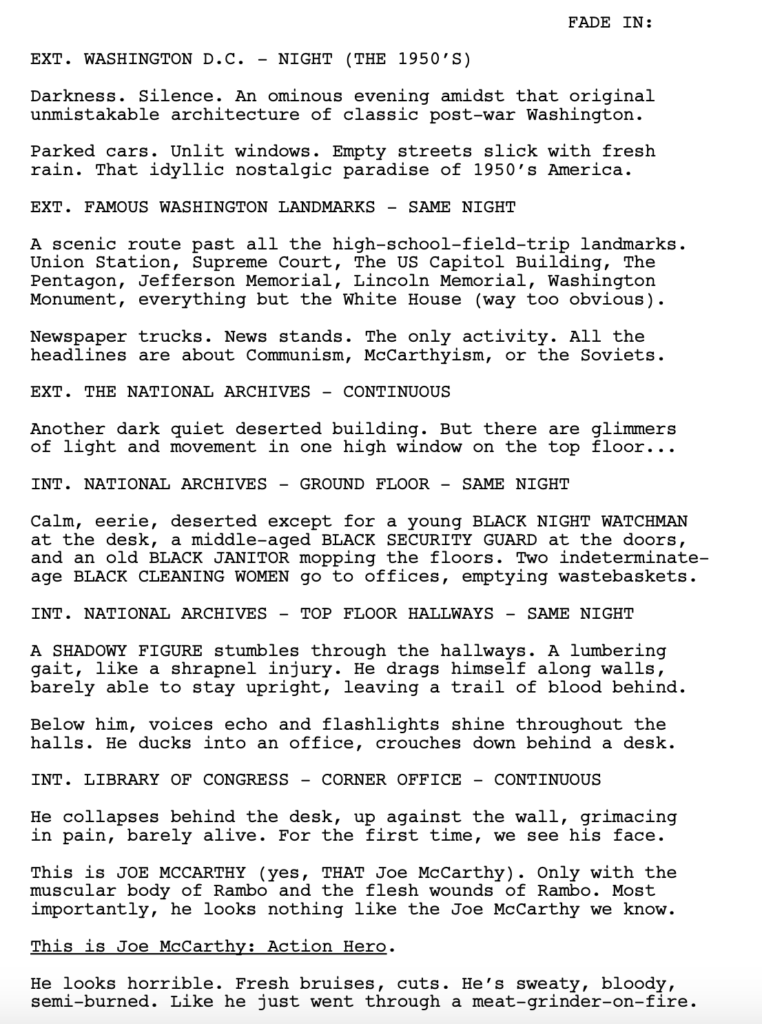

The showdown is finally here. The five submissions that most piqued my interest will be posted tonight for the first Showdown of 2022! Then, over the weekend, you, the readers, will read as much of each script as you can and vote on which one you think is best. Whoever gets the most votes will get a review next week.
For those of you good at math, you may have figured out that THERE’S STILL TIME LEFT TO ENTER. You have until tonight (Thursday, February 24) at 10pm Pacific Time to send your submission. I need your title, the genre, a logline, A PDF OF THE SCRIPT, as well as why you think your script deserves to be chosen for the showdown. This is where you pitch me the bigger story about you, or your script, in the same way that, if you were on a press tour, you’d be trying to get people to go out and see your movie.
Entries should be sent to carsonreeves3@gmail.com
Now might be a good time to remind everyone of the protocol for last second entries. You will be tempted to rewrite dialogue, rewrite entire scenes even. DON’T DO THIS. The only thing you have time to do right now is proofread. Make sure those first five pages, in particular, are error-free. And then proofread as much of the rest of the script as possible.
If you rewrite dialogue, you run the risk of erasing important info. Good writers have ensured that their dialogue is seamlessly packed with exposition and character development. By rewriting dialogue at the last second, you risk erasing all that. And you’ll kick yourself for doing it later.
Also, the main reason you’re tempted to replace dialogue in the first place, is because you’re tired of the dialogue you have. It’s not because the dialogue is bad. You’re just sick of it cause you’ve read it OVER and OVER and OVER again. Your dialogue is likely fine the way it is. You don’t need to rewrite it.
And same goes for reimagining or erasing scenes. I remember being hours away from a contest deadline and thinking, “I don’t like this one scene. I don’t need it.” And so I deleted the scene, only to remember, after I’d sent the script off, that the scene set up a critical reveal during the climax. That kind of sh#t happens ALL THE TIME when you do last second rewrites.
Also, be thankful that all of you live in an age where screenwriting software takes care of all the margins and spacing for you. Back in the day, you’d have to block off an entire week just to clean up all the formatting in your screenplay.
Can’t wait to see what all of you have baked up!
Genre: Sci-Fi/Drama
Premise: A young woman and her devoted boyfriend’s lives are dramatically altered by a medical procedure that could potentially quadruple their lifespans.
About: Clearly, Matt Kic and Mike Sorce have a love for weird life-extending dramatic sci-fi ideas. They sold a script to Netflix in 2019 called, The Second Life of Ben Haskins, about a guy who gets cancer then goes into stasis until they can transfer his brain into a new body. So this is well-tread territory for them. By the way, these two loved contests before they sold their first screenplay, and the good news for all you aspiring screenwriters out there is, THEY NEVER WON! They semi-finaled a lot. But that’s as far as they got. To be honest, semi-finaling is usually a good sign in contests because often contests want to celebrate an artsy or profound script, which leaves the Hollywood scripts – the cool higher concept ideas – back in the semi-final round. So next time you semi-final in a contest, start looking for houses in the hills cause you’re about to hit it big!
Writers: Matthew Kic & Mike Sorce
Details: 118 pages

Today’s screenplay has a whopper of a twist. But does that twist result in a script worth reading? Let’s find out!
Maddie and Julian, both eight years old, are inseparable ballet dancers. They’re best buddies times a million. After a strenuous day of practice, Maddie gets word that her father is in the hospital. Her mother races Maddie there and her dying dad cryptically tells her not to screw up her life like he did.
Twenty years later, Maddie is still dancing and STILL with Julian. The two are so in love they got matching birdcage tattoos on their wrists. Maddie is a nurse at a place called Dohrnii Medical where she changes bed pans for a guy known as “Gramps,” and has daily battles with protesters, who are mad that Dohrnii offers a new medical procedure to increase your lifespan four-fold.
Maddie, who is still shaken by her father’s death, wants to get the procedure. But to do so would mean becoming sterile. This is something Julian does not accept. He wants to have many kids with Maddie. Maddie is so mad about Julian not wanting the procedure that she goes and bangs her new 40-something dance teacher, Mr. Ford. I’ve seen some rash decisions in my life but that was a little extra, Maddie.
When Julian next leaves town, Maddie secretly gets the procedure, which effectively ends their relationship. Before Maddie can process this, she finds out that her mom is dying. A week later, we’re at the funeral. Right before it starts, Mr. Ford shows up. After exchanging pleasantries, Maddie checks Mr. Ford’s wrist where we see… a birdcage tattoo?
Wait, wtf is going on here? Maddie gets birdcage tattoos with every guy she sleeps with? No. Actually. This is where we learn that Julian, Mr. Ford, and Gramps…. ARE THE SAME PERSON! We’ve been unknowingly jumping back and forth in time throughout the first 30 pages. Since Maddie doesn’t age, we just assumed all of this was happening in the present.
The rest of the script linearly follows Maddie in the year 2025, when she’s a hot mess alcoholic, in 2051, when she tries to conquer her dream of becoming a professional ballet dancer, and in 2083, where she looks back at all the dumb choices she made, particularly the one where she screwed over Julian. In the end, Maddie will learn whether becoming a “jellyfish” was worth it or not.
I think I would’ve titled this, “Hot Mess Jellyfish.” Cause it’s really about a character who is a total mess and has no idea what she wants, navigating her never-ending 20s over the course of 60 years.
I’m not sure how I feel about Jellyfish Days because it’s such a weird script. On the plus side, it’s not like anything else out there. On the minus side, it’s messier than my bedroom all throughout high school. It has these great moments, such as when we realize these three men we’ve been seeing have all been the same guy (Julian). And then it has silly moments, like this whole ‘follow your dream’ ballet storyline, which feels too lightweight for a movie tackling themes as heady as time and aging.
I do like that the script follows my advice of figuring out what’s unique about your concept and building your story around that. Because that’s going to be what separates your script from every other script. What’s unique about this story is that the main character lives for 300 years. So the writers smartly built in this storyline whereby we see all these aspects of Maddie’s life only to later learn they were happening in different time periods. That is a choice SPECIFIC to this concept.
I also thought it was a bold choice to drop that twist on page 30. Most writers would be tempted to save the twist til the end. The problem with saving twists for that long is that you have to lie for too long. You must strategically keep things out of the story that would normally be there. And if you do that enough, the story starts to feel distant, vague.
I’ll give you an example. Early in the script, Maddie and Julian have a fight about her getting the de-aging procedure. The next scene is her running through the rain to Mr. Ford’s house, ringing the doorbell, and when he answers, banging him. When I read that, I hated Maddie. She’s spent her whole life with Julian and all it takes is one argument to send her off having sex with her teacher?? Talk about a cold hearted b-word.
Of course, when we learn Julian and Mr. Ford are the same person, it makes sense. But had they waited until page 120 to tell us that, we would’ve hated her that whole time. And we would’ve been confused. There was nothing between her and Mr. Ford, up until that point in the movie, that would make you think she’d want to be with him. Of course, that’s because the writers can’t tell us too much lest we be onto them.
So it becomes this dance of lies you’re building and building for one shining moment at the end of the film. And while we’ve seen it work – The Sixth Sense – it more often than not doesn’t. So I like that these guys understood that and told us earlier.
I also like that the writers made some bold choices. For example, at first, I was annoyed by all the melodrama. Dad is dying of liver failure. Mom is dying of cancer. Big dramatic divorces are happening. These are the kinds of things you typically see in daytime soap operas. But the more I thought about it, the more I realized that all of this stuff fit the themes of the movie, which came down to the question, “What are the unique things you encounter when you live forever?” And experiencing a lot more heartache than the average person was a logical extension of that theme.
Still, the script is so freaking messy, it’s frustrating. Following your dreams is a subplot for an Addison Rae Netflix movie. It shouldn’t be part of a story trying to make this big profound statement. And then there’s this weird “secret son” storyline that pops up late. Apparently Maddie and Julian had a kid and she gave him up for adoption. But I thought the whole reason they broke up was because she wouldn’t have his kid. I had no idea what was going on there.
With that said, the script is one of those rare instances of something that’s discussion worthy. Yesterday’s script was the anti-discussion worthy script. But this actually has some stuff in it to talk about. And, for that reason, I’d say it’s worth checking out.
[ ] What the hell did I just read?
[ ] wasn’t for me
[x] worth the read
[ ] impressive
[ ] genius
What I learned: This script could’ve used one more plot point. We coasted after page 30, patiently moving through each of the three time periods Maddie lived in. And it got a little boring. An easy place to find a plot point in these high-concept scripts is to use the “and then sh#t goes wrong” tool. If your hero gains the ability to fly, at some point, sh#t needs to go wrong as a result of that power. If your hero gets into Harvard, at some point, sh#t needs to go wrong. If your hero wins the lottery, at some point, sh#t needs to go wrong. Sh#t going wrong is where all the fun is. The writers were so focused on the character side of this equation, they overlooked a potential ‘sh#t goes wrong’ plot point in Jellyfish Days that could’ve spiced up a slow narrative.


